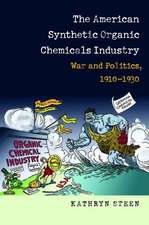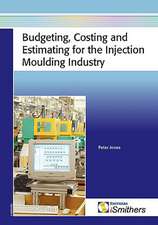The Chemical Industry
Editat de C. A. Heatonen Limba Engleză Paperback – 31 dec 1993
Preț: 651.34 lei
Preț vechi: 766.28 lei
-15% Nou
Puncte Express: 977
Preț estimativ în valută:
124.65€ • 129.15$ • 104.03£
124.65€ • 129.15$ • 104.03£
Carte tipărită la comandă
Livrare economică 22 martie-05 aprilie
Preluare comenzi: 021 569.72.76
Specificații
ISBN-13: 9780751400182
ISBN-10: 0751400181
Pagini: 384
Ilustrații: XVI, 384 p. 4 illus.
Dimensiuni: 189 x 246 x 23 mm
Greutate: 0.72 kg
Ediția:2nd ed. 1994
Editura: SPRINGER NETHERLANDS
Colecția Springer
Locul publicării:Dordrecht, Netherlands
ISBN-10: 0751400181
Pagini: 384
Ilustrații: XVI, 384 p. 4 illus.
Dimensiuni: 189 x 246 x 23 mm
Greutate: 0.72 kg
Ediția:2nd ed. 1994
Editura: SPRINGER NETHERLANDS
Colecția Springer
Locul publicării:Dordrecht, Netherlands
Public țintă
ResearchCuprins
1 Introduction.- 1.1 Development of the chemical industry.- 1.2 What the chemical industry does.- 1.3 Characteristics of the industry.- 1.4 Sectors of the industry.- 1.5 Conversion of chemicals into consumer products.- 1.6 The chemical industry.- 1.7 Quality and safety.- 1.8 Environmental aspects.- 1.9 The importance of team-work.- References.- 2 Quality and safety issues.- 2.1 Quality.- 2.2 Health and safety.- Acknowledgements.- References.- 3 Environmental issues.- 3.1 Introduction.- 3.2 Some environmental disasters.- 3.3 Public response to the disasters.- 3.4 The chemical companies’ response.- 3.5 The way forward?.- 3.6 Conclusions.- References.- 4 Polymers.- 4.1 Introduction.- 4.2 Molecular weight of polymers.- 4.3 Chemistry of polymerization.- 4.4 Homopolymers and copolymers.- 4.5 Manufacture of polymers.- 4.6 Properties of polymers.- 4.7 Thermoset polymers and cross-linking.- 4.8 Elastomers (rubbers).- 4.9 Fibres.- 4.10 Present and future developments in polymer chemistry.- 5 Dyestuffs.- 5.1 Historical aspects.- 5.2 Classification and nomenclature of dyes.- 5.3 Colour and constitution.- 5.4 World production.- 5.5 Major products.- 5.6 Application and fastness properties.- 5.7 Dye manufacture.- 5.8 Current and future trends.- References.- 6 The sulphur, phosphorus, nitrogen and chlor-alkali industries.- 6.1 Introduction.- 6.2 Sulphuric acid.- 6.3 Phosphorus-containing compounds.- 6.4 Nitrogen-containing compounds.- 6.5 Chlor-alkali and related compounds.- 6.6 Conclusion.- 6.7 The future for basic chemicals.- Bibliography and recommended reading.- 7 Agrochemicals.- 7.1 Introduction.- 7.2 Present position of the industry.- 7.3 Discovery and development of new pesticides.- 7.3.1 Outline schemes.- 7.4 Fungicides.- 7.5 Herbicides.- 7.6 Insecticides.- 7.7 Pesticideresistance.- 7.8 Integrated pest management.- 7.9 The future.- References.- 8 The pharmaceutical industry.- 8.1 Introduction.- 8.2 The world pharmaceutical market.- 8.3 The initiation of a project in the pharmaceutical industry.- 8.4 Financial and economic considerations.- 8.5 Health benefits.- 8.6 Future trends.- 8.7 Sources of information on drugs.- References and bibliography.- 9 Biological catalysis and biotechnology.- 9.1 Introduction.- 9.2 Microbial synthesis of primary metabolites.- 9.3 Microbial synthesis of secondary metabolites.- 9.4 Microbial synthesis of proteins.- 9.5 Microbial transformations.- 9.6 Enzymatic processes.- 9.7 Clean chemistry.- 9.8 Enzymes in unusual reaction conditions.- 9.9 Laboratory scale synthesis (the chiral switch).- 9.10 A new catalysis.- References.- 10 The future.- 10.1 Current situation.- 10.2 Significant influences.- 10.3 The future.
Recenzii
`...I enjoyed the book and I believe students will also find it useful.'
Chemistry & Industry
Chemistry & Industry
















